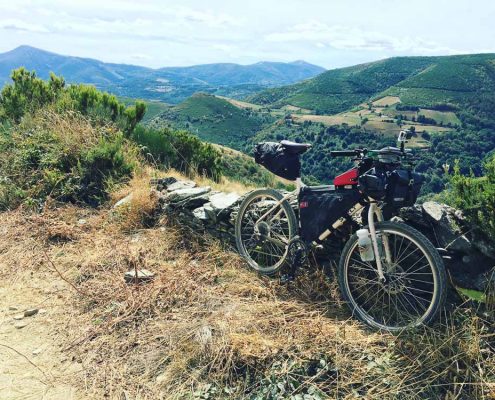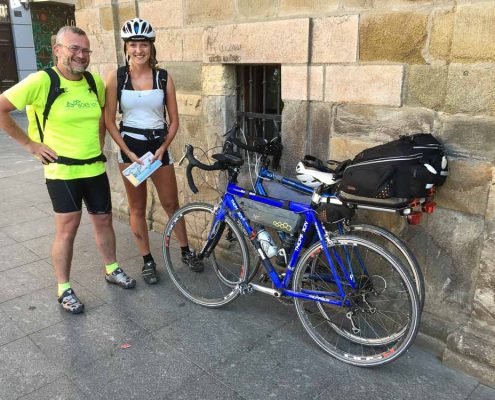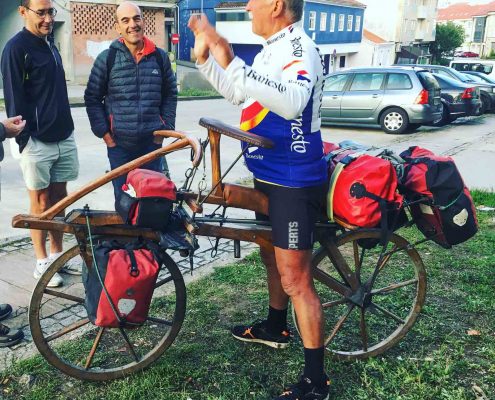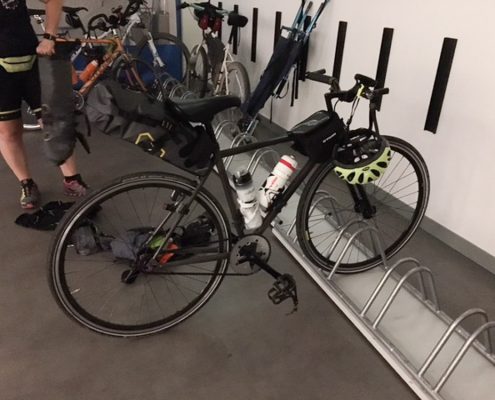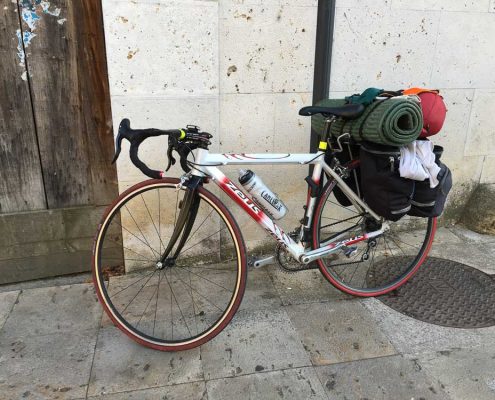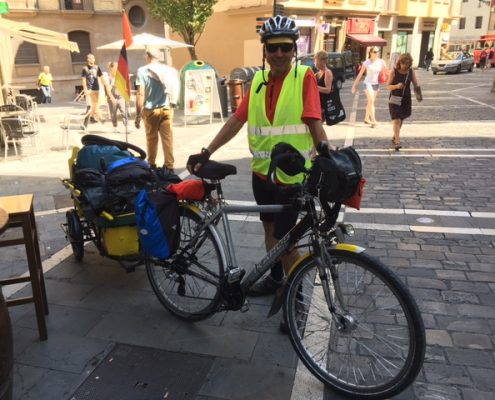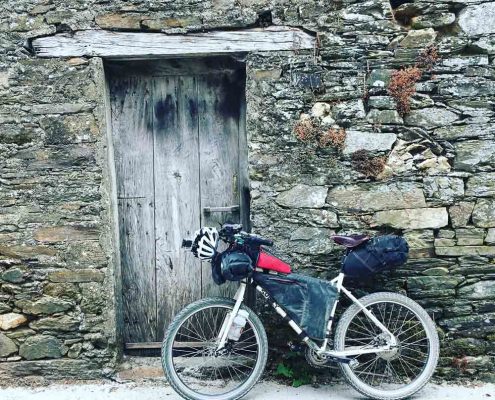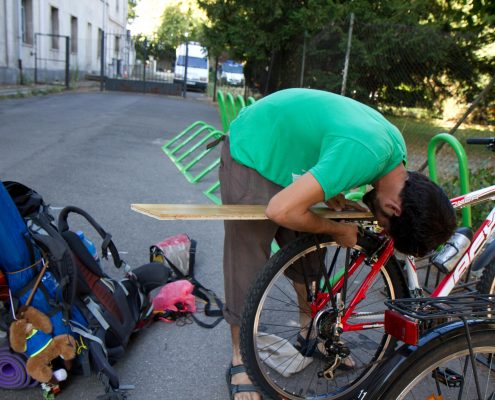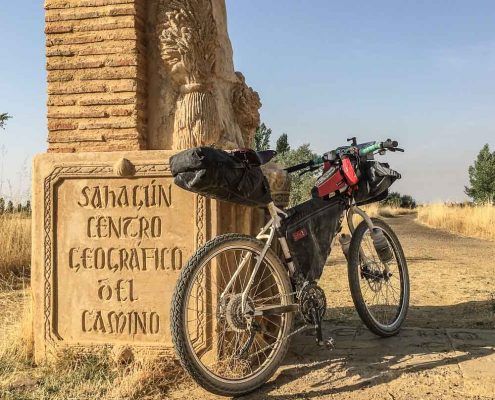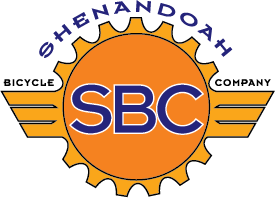Types of Travel Bikes
Almost any bicycle* can be suitable for the Camino, as the abundance of amenities along the route don’t require a heavy touring load, and the fact that there are alternates on the paved roads to avoid rough trails. Your riding style, preferred method of carrying gear, and budget will help determine which option is best for you. The most common setup currently seen on the Camino is a mountain bike with front suspension and rear racks and panniers, however dedicated touring and adventure bikes present more options for comfort, durability.
*Avoid “department store bikes,” which will not be worth however little they cost, and will likely compromise your safety along the way. A 15-year-old bicycle from a reputable company will be a more reliable choice. If you have any doubt about the quality of your bicycle, visit your local bike shop.
Road Bikes
Light, fast bikes with skinny tires and drop handlebars designed for paved roads
- Frames/forks: steel, aluminum, carbon, titanium
- Handlebars: drop bars
- Wheels: 700c, fewer spokes to save weight
- Tires: 700c x 18-28mm, skinny and high pressure for maximum efficiency on paved roads
- Touring suitability: light credit-card style touring only, limited options for attaching racks to frame or carrying heavy loads
Cyclocross Bikes
Road bike but with more clearance for wider and knobbier tires for dirt/graving racing
- Frames/forks: steel, aluminum, carbon, titanium
- Handlebars: drop bars
- Wheels: 700c, fewer spokes
- Tires: 700c x 28-35mm, aggressive tread for off-pavement riding
- Touring suitability: light credit-card style touring only, limited options for attaching racks to frame or carrying heavy loads, tougher beyond the pavement than road bikes
Hybrid Bikes
Cross between a road and mountain bike, may have front suspension, becoming less common for touring with more specialized options available
- Frames/forks: usually aluminum or steel
- Handlebars: straight bars, often very upright
- Wheels: usually 700c
- Tires: 700c x 28-44mm
- Touring suitability: great option for mixed terrain touring, check for tire clearance, rack attachment points, comfort and fit
Mountain Bikes
Designed for riding on unpaved roads & trails with wide tires, many have suspension for more control & comfort on rough trails
- Frames/forks: Steel, aluminum or carbon, can be rigid (no suspension), have a front suspension fork or dual suspension
- Handlebars: straight bars
- Wheels: 26″, 27.5″, 29″
- Tires: widths of 2″ to 4+”
- Touring suitability: depends on the bike, many have options for rear racks & panniers, most bikepacking bags are compatible with almost any mountain bike (except frame bag)
Traditional Touring Bikes
Traditional touring bicycles are intended to be tough, comfortable, more upright,carry a heavy load, have a longer frameset, and many options for attaching front and rear racks, fenders and water bottles. Intended for paved and unpaved road touring.
- Frames/forks: steel is preferred, sometimes aluminum
- Handlebars: Usually drop bars, sometimes straight or alternative Jones-type for more hand positions
- Wheels: 26″ and 700c, 36 spokes
- Tires: 26x 1.2″ – 2.1″, 700c x 28-42mm
- Touring suitability: designed for road touring and carrying heavy loads, best for everything except touring off-road touring
Adventure Bikes
An emerging category of touring bikes designed to go anywhere. Designed for round-the-world touring with maximum options for wide tires, racks, panniers, bottle cages, anything.
- Frames/forks: steel only, usually avoids supsension by increasing tire volume
- Handlebars: usually not drop bars, but something more versatile/upright
- Wheels: usually 26″ & 36 spoke
- Tires: 26 x 1.5″ to 2.75″
- Touring suitability: will take you anywhere, only limitation could be weight, budget
Other notable bike types: Tandems, Folding, Recumbents
Component Considerations
The following section discusses bicycle component consideration for all types of bicycles that may be used for touring. By converting these components to a touring setup, many bicycles (including the one you own!) can be great for touring. There is no end to the debate on many of these topics (and destination-dependent variations beyond the scope of this page), but what is recommended here is the general consensus and what we have found to work best in our experience.
- Frame material
- Best for touring: STEEL. Steel is known to be comfortable, repairable and relatively affordable. Have your frame welded anywhere in the world, trust it on rough roads. Some touring-specific bikes have aluminum frames, but they are becoming more of a minority as steel frames are getting stronger and lighter.
- Avoid: Carbon frames, poorly-made aluminum frames
- Frame geometry
- Best for touring: upright & comfortable, extended wheelbase for heel clearance for panniers, handles well with your preferred gear-carring setup (racks/panniers or bikepacking)
- Avoid: anything that is obviously uncomfortable, aggressive stances
- Suspension
- Best for touring: rigid or front suspension, wide/high-volume tires can make up for suspension and rigid bikes are becoming the norm.
- Avoid: full suspension, any system that requires complex maintenance/tools/supplies
- Wheels
- Best for touring: 26″ or 700c are common, touring specific wheels that have 36 spokes, are hand-built or trued by a knowledgeable mechanic. 26″ wheels are more common for remote, international touring beyond the developed world as they present a more common size for spare tires and tubes
- Avoid: weak wheels (fewer than 32 spokes, out of tension/true), non-standard sizes like older 27″. Have a reputable mechanic look at your wheels before any long tour.
- Tires
- Best for touring: depends on your surface type, but usually not thinner than 1.5″ or 32mm, ideally something that rolls well on pavement, but has more grip on the edges for gravel road turns and slippery weather, durable tread and sidewalls. Many swear by Shwalbe’s Marathon Plus & Mondial lines (expensive and heavier, but could take you around the world with minimal flats)
- Avoid: cheap tires, tires too thin for your terrain and load
- Handlebars/stem
- Best for touring: depends on what is most comfortable for your preferred riding style and offers a variety of hand positions. Wrap and pad your bars for increased cushioning and grip. Be sure to leave enough space for mounting any accessories (shifters and brake levers, bike computer, GPS, bell, aero bars)
- Avoid: anything too aggressive or leaning forward, straight bars that limit hands to only one position (consider bar end extensions)
- Saddle
- Best for touring: a very personal question. Most cyclists prefer smaller, harder saddles to large, cushiony ones, but this may depend on how upright your stance is, your personal anatomy. Consider a leather Brooks saddle, which are known to be the most comfortable, but will take some time to break in.
- Avoid: a saddle you haven’t put long days and hundreds of miles on, and perfected its fit
- Brakes
- Best for touring: Cantilever or disc brakes (mechanical). Cantilever are simpler, more globally repairable, but lack the stopping power of disc brakes, which are becoming the new standard for many touring bikes. Test your loaded bike and be sure you are comfortable with your stopping ability when going downhill.
- Avoid: Hydraulic disc brakes (annoying to service on tours), any older brake that has not had its cables or brake pads changed recently.
- Gearing
- Best for touring: a triple chainring with a mountain bike cassette. Be sure to have low gearing for long, relenteless climbs, and be sure to test your setup while loaded before your tour. Pushing too high of a gear with weight on your bike is a great way to break spokes and mess up your wheels.
- Avoid: drivetrains with only higher gears for road riding
- Pedals
- Best for touring: Clipless pedals with mountain bike shoes. Clipless pedals (click in to cleats on a cycling shoe) are the most efficient setup as they transfer most of your power into the pedal as well as help maintain control of your bike with a solid attachment between foot and pedal, and the standard for most bike tourers. Some people prefer a rigid shoe (like hiking boots) on flat pedals, as the shoe is more versatile off of the bike. Toe clips & straps are becoming more outdated, but are still used by some cyclists.
- Avoid: stock, flat pedals
Notable Touring bike models (US & UK)
Few companies specialize in touring specific bikes. Leading the pack are Surly & Salsa Cycles, which have offered rugged options that will take you almost anywhere at a great value. In the UK, Thorn’s touring cycles have been known for their durability and quality as world touring bikes.
- Long Haul Trucker (26″ & 700c) – $1,350
- Disc Trucker (26″ & 700c) – $1,449
- Troll – $1,700
- World Troller (S&S couplers, 26″) – $1,150 (frame/fork only)
- Ogre (29″) – $1,649
- Marrakesh (700c/29″) – $1,599
- Vaya (700c) – $1,099-$1,799
- Fargo (29″) – $1,699 (hard tail) – $2,499 (front suspension, disc brakes)
Soma:
- Saga (26″/700c) – $1,495
Trek:
- 520 (700c) – $1,429
Novara (REI brand, US):
In the UK, these brands are noteworthy:
Thorn (UK)
Ridgeback (UK)
- World Expedition (26″) – £849
Genesis (UK)
- Tour de Fer 20 (700c) – £1,299
See a massive list of expedition touring bikes available from many countries.

